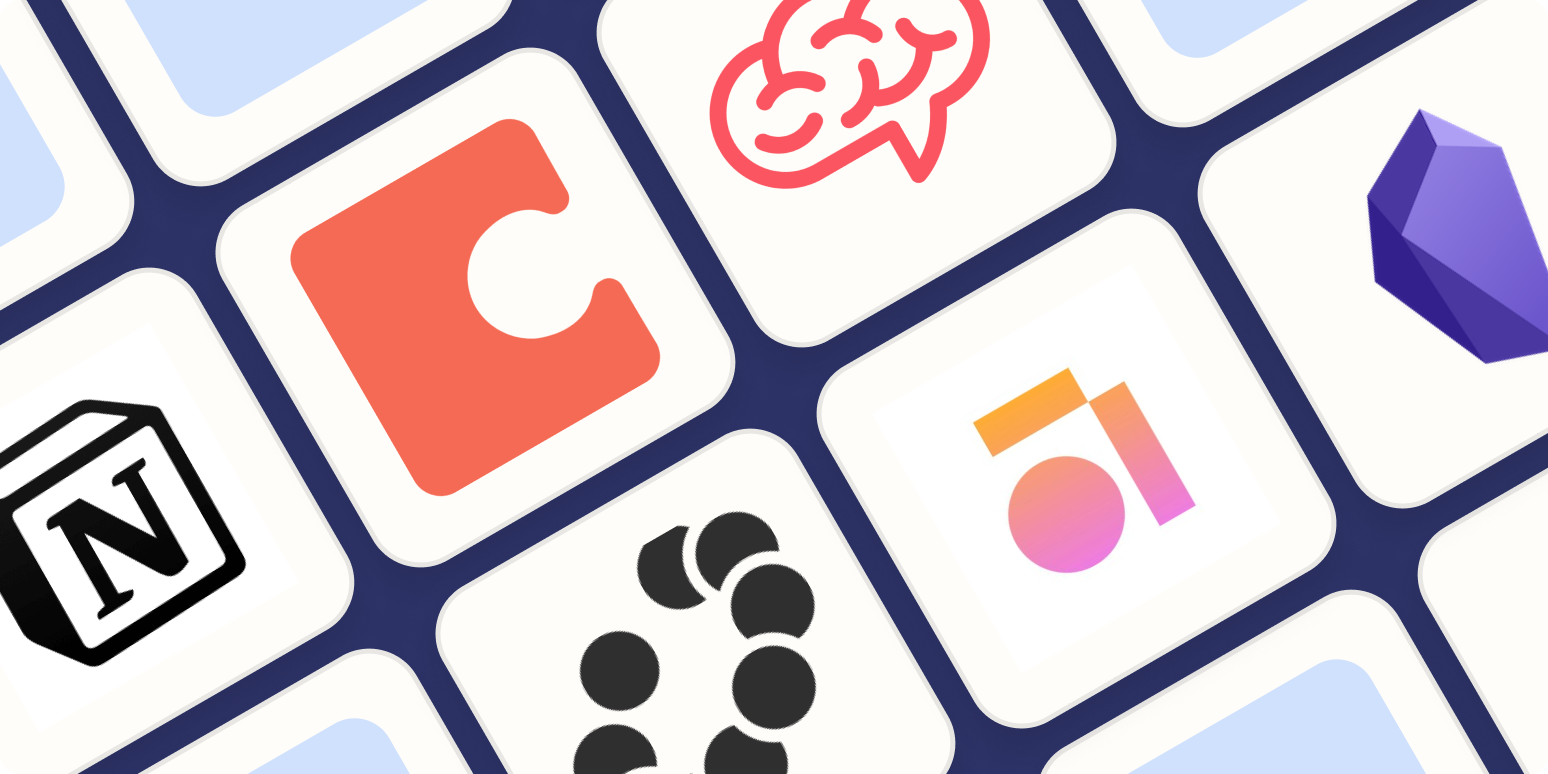Notion has that “I don’t know what” that makes organizing information, setting up your personal productivity system, and collaborating with others an absolute breeze. It might be the minimalist interface, the building blocks philosophy, or the intuitive slash commands; whatever it is, the whole app comes together in a powerful and unique user experience.
Turn your Notion workspace into an information hub
But after the honeymoon period, power users start feeling the edges of freedom, very much like Truman inside his show. You expect the app will accommodate your every wish and command, only to find that there are, in fact, limitations.
If you’ve been considering a Notion alternative—or strapping a dozen apps together to get all the features you want—you’re in the right place. I considered and did in-depth testing on dozens of Notion alternatives for all skill levels (and all levels of ambition), and these are your best options.
The 5 best Notion alternatives
-
Coda for powerful formulas and databases
-
Nuclino for knowledge management
-
Slite for collaborating as a team
-
Anytype for privacy, security, and data relationships
-
Obsidian for fearless tinkerers
And, of course, Notion itself.
What makes a great Notion alternative?
How we evaluate and test apps
All of our best apps roundups are written by humans who’ve spent much of their careers using, testing, and writing about software. We spend dozens of hours researching and testing apps, using each app as it’s intended to be used and evaluating it against the criteria we set for the category. We’re never paid for placement in our articles from any app or for links to any site—we value the trust readers put in us to offer authentic evaluations of the categories and apps we review. For more details on our process, read the full rundown of how we select apps to feature on the Zapier blog.
Ideally, a great Notion alternative gives you the freedom to create your own productivity system—your network of documents, databases, and references—without forcing an inflexible user experience on you.
A bit like a sandbox video game, this category of app (which doesn’t really have a name yet) gives you the possibility to mix and combine different elements to create your or your team’s all-in-one workspace.
Each of the picks on this list has something unique to offer, along with some twists on the original experience you’re used to. But to start, I evaluated all the apps that I tested using the same criteria:
-
Document and note-taking features. How easy is it to create, format, share, and embed content? This blank-slate document vibe is the bread-and-butter of Notion, so I wanted to be sure the alternatives stacked up.
-
Project management features. Can you create to-do lists? Kanban boards? What about leaving comments on documents? Can you mention coworkers?
-
Database features. All of these apps run on some form of database, but they vary in the way they give you the power to create views and relationships between data. I made sure to evaluate how much control and creativity you can have here.
-
Performance and user experience. I was paying attention to speed, how the search function works (and where it searches), as well as other details like the quality of the user interface, onboarding experiences, and available support.
-
All-in-one potential. Based on all the above, could this app reliably hold all your information and processes in one place without requiring you to connect loads of apps together?
The way each development team approaches this kind of app is unique. This leads to some apps being absolutely amazing in two or three of the features but abysmal or very light in others. But in making my final picks, I tried to make sure that each app was relatively well-rounded.
The gold standard
Notion (Web, Mac, Windows, iOS, Android)
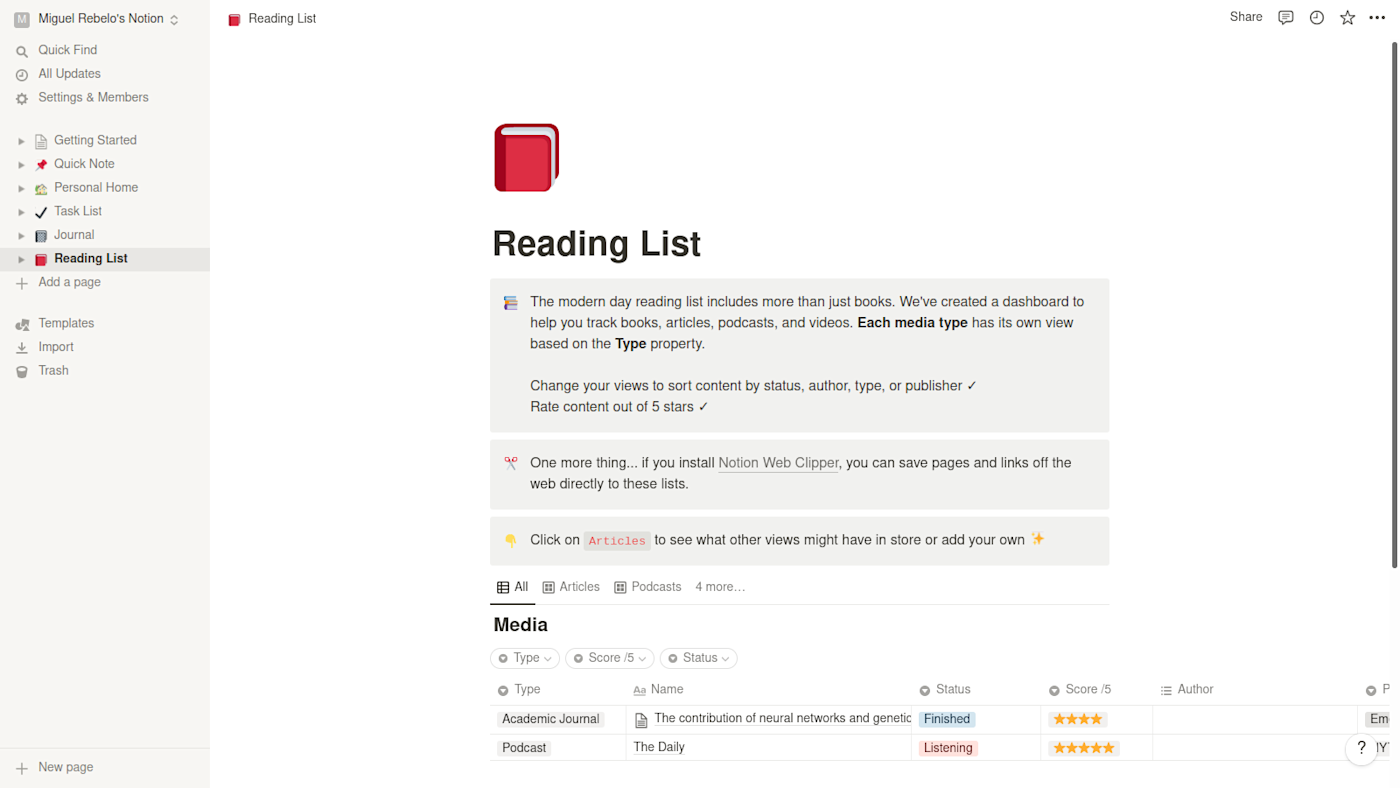
A list of Notion alternatives wouldn’t be complete without naming the elephant in the workspace. Finding an alternative to Notion is hard because this all-in-one workspace category has so many differing philosophies and approaches—and because Notion has created something so unique and powerful that it’s hard to replace.
Using Notion for the first time feels like a new power was thrust upon you. You can finally ditch a collection of apps to handle your life and just focus on a single one, building your own information hub and customizing the way you want to.
The user experience is streamlined and minimal, putting your content at the forefront of the experience. There aren’t lengthy onboarding tutorial tracks: the tool explains itself as you use it. The building blocks method is easy to grasp, inviting you to reorganize and rearrange your document into custom dashboard pages, proto-apps, and mood boards, to name some of the possibilities.
The collaboration features are simple. Creating comment threads on documents and mentioning other people feels enough to keep everyone on the same page. Like most apps in this category, Notion also invites you to integrate Slack, so you can take your longer conversations there.
But creating documents isn’t Notion’s only purpose. Ivan Zhao, Notion’s co-founder and CEO, pointed out in the March 2022 newsletter that the addition of the database experience is what turned the app from something the dev team thought was cool into a tool that reached a wider audience and adoption. This focus on databases added new powers to Notion: the ability to change database views to Kanban cards, galleries, or filtered lists gives you the freedom to organize and cross-reference your content in any way you like. And these features also give you an edge in project management.
With so much on offer—coupled with a very generous freemium model—it’s no wonder Notion feels like the ultimate all-in-one workspace experience. But this experience isn’t without its hiccups. The platform has been widely criticized for performance issues, lack of end-to-end encryption or offline mode, a clunky mobile experience, and the way some searching features have a temperament of their own.
The good news is that there are solid alternatives on the market to explore. The bad news is that each app has its own interpretation of what an all-in-one workspace should include and how it should behave. Finding an alternative to Notion is more like finding an app that aligns with your use case, not finding an app that would make Notion obsolete.
So, if your Notion love story has reached long silences and cold shoulders, keep reading for some options to ignite your all-in-one productivity spark again. And if you’re not ready to switch, that’s ok. Connect Notion to Zapier, so you can upgrade your Notion experience and connect it to the other apps you use. Here are some examples.
-
Notion difficulty: Beginner; tweaking databases comes with a learning curve.
-
Notion pricing: Generous personal free plan with unlimited blocks and total storage, with a 5MB upload limit and limited collaboration features. Paid plans start at $4/month (billed annually).
Best Notion alternative for powerful formulas and databases
Coda (Web, iOS, iPadOS, Android)
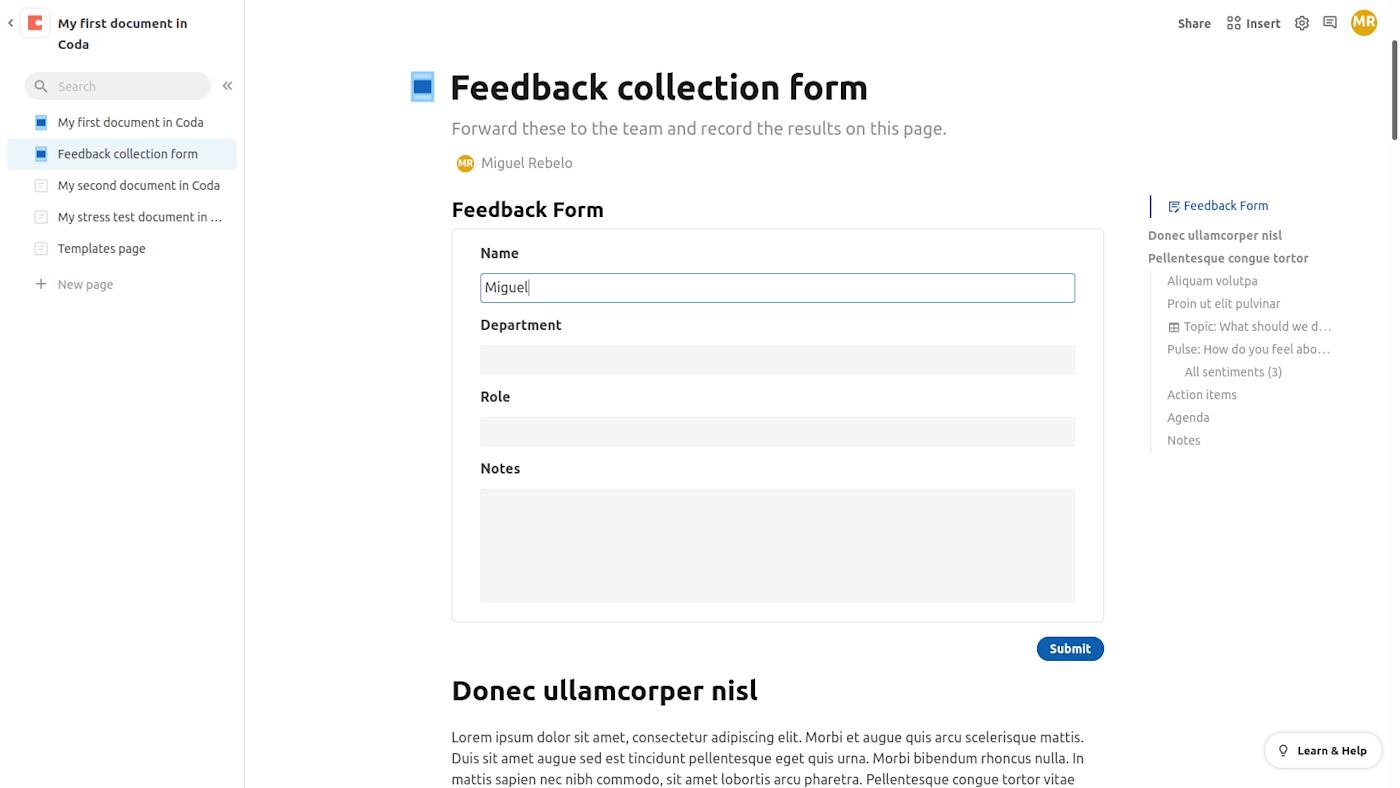
When you visit Coda‘s home page, the message is clear: “I’m tired of this sheet.” Being tired of the classic spreadsheet experience as the paragon of productivity may be what drove Coda’s team to create a tool with very strong database features.
But first things first. When compared with Notion, Coda has a different philosophy in terms of workspace organization. The dashboard provides information on your workspace at a glance, helping you keep track of your documents and your team’s documents. This isn’t a totally blank-slate-start setting, but it’s a welcome addition if you value having a dashboard page ready to go.
When you jump into a document, the blank slate feeling comes back. And Coda has some extras here. The document outline docked on the right side of the screen is great for long documents where you have to move around a lot (Notion’s table of contents sits in the document, not in a sidebar). You can also insert and program buttons into documents, with actions like “duplicate this document” or with a custom formula.
Coda’s Packs feature allows you to embed other apps into your documents. I connected Coda with Google Calendar, which unlocked a set of elements and formulas I could put in the document to show my schedule and add new events with a button. It even suggested some templates I could use with the integration. It’s like a toolbox you can use to bring Coda together with other apps—something I was personally surprised and delighted by.
As you might expect, databases are the main course. There are more views available than in Notion, including the possibility to create forms and collect responses directly by sharing them (a huge step up from having to add a survey app to your tech stack).
And once you start using “Coda’s book of spells” (formulas), it’s easy to see how much potential this app has for creating workflows and automation. Type = anywhere, and away you go: choose which database or pack you want to pull data from, and which formula you want to apply to it. You don’t have to be inside a spreadsheet or table to use it—you can write a formula anywhere you want.
A user on Reddit made an interesting distinction when it comes to Coda vs. Notion: if you handle documents and wikis, Notion is stronger; if you need databases and more automation, Coda comes out on top. There’s no clear winner between the two apps. It seems each acts on the shortcomings of the other.
In terms of performance, Coda is less agile than Notion, especially when opening documents. If you’ve used Google Docs in the past, it’s that kind of response time: it doesn’t make you wait, but it isn’t entirely snappy either.
Coda is probably Notion’s most direct competition and the most natural alternative to it. If you value a powerful database and spreadsheet experience at the core, with the ability to add formulas anywhere, then Coda is sure to make you “excited for this sheet” again. And you can take advantage of it even more by connecting Coda to Zapier, so you can do things like create new rows in Coda when things happen in your other apps. Here are some examples.
-
Coda difficulty: Beginner; taking advantage of formulas comes with a moderate learning curve.
-
Coda pricing: Free plan comes with access to free packs and real-time collaboration features but imposes document size limits (up to 50 elements and 1,000 rows per document). Paid plans start at $10/month per document maker (billed annually); viewers and editors are free.
Best Notion alternative for team knowledge management
Nuclino (Web, Mac, Windows, Linux, iOS, Android)
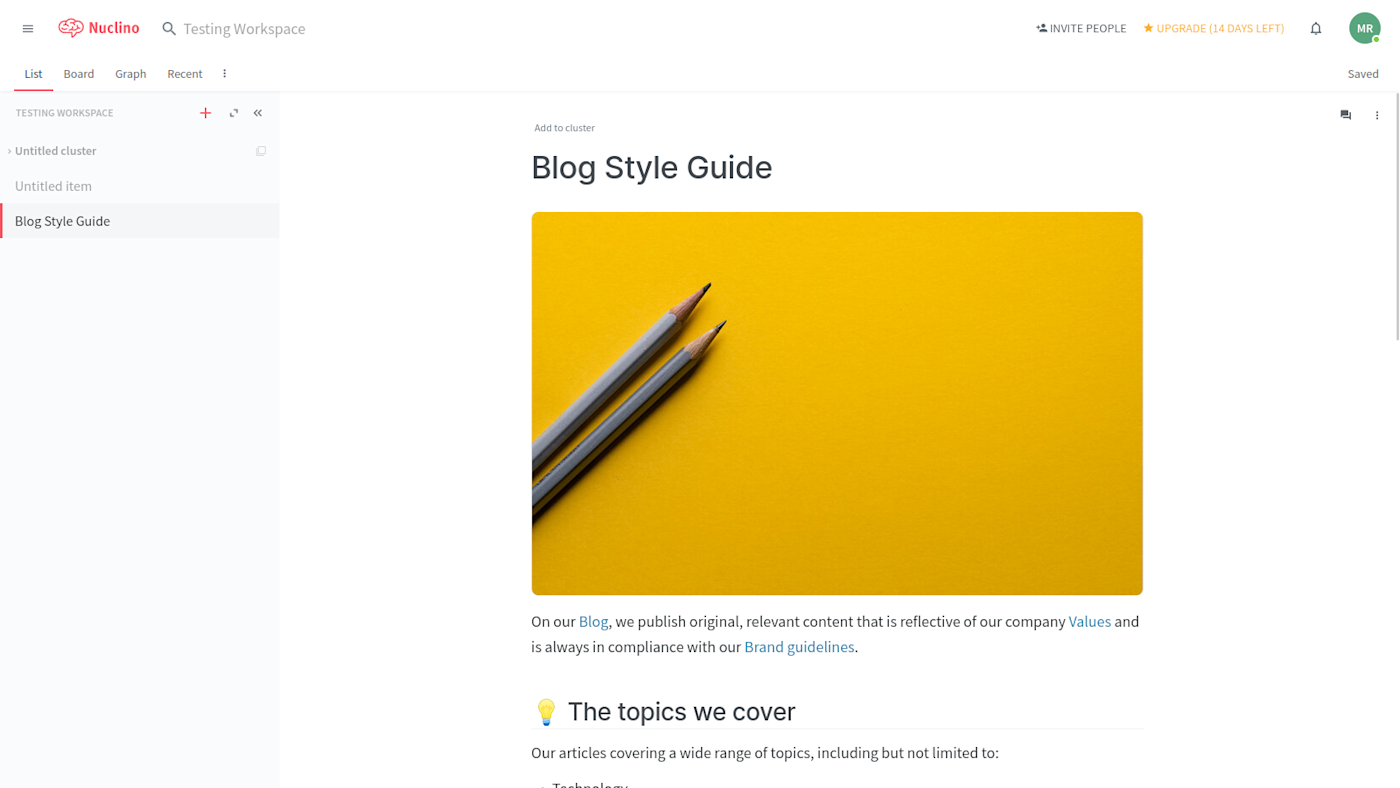
Nuclino captures Notion’s core experience well while adding its own set of twists. You can use it as a personal knowledge management solution, but it’s tailored to managing knowledge at a team level.
The user interface has a minimalist feel, with Nuclino’s brand color as a nice aesthetic accent. The way the content is laid out reminds me a bit of a Wikipedia page, with the divider right under each H1 header element. I like how space is handled on the page: the amount of space after headings and paragraphs is generous, making for an easier reading and skimming experience. The slash menu is discreet and contains all you need to format your documents and add app integrations.
I installed all the templates Nuclino offered me during the onboarding experience, and all seemed to suggest a similar approach: you can create clusters in each workspace—topic pages that you can pin with instructions or an introduction—and nest within them all the documents and links to help your coworkers find what they need, whenever they need it. The collaboration features are in line with the standards (comments, comment threads, and mentions), offering nothing more and nothing less than the essential.
The database features exist in Nuclino, but they don’t have the same experience as in Notion. You can’t create a database within a document and configure views in any way you like. Instead, the whole workspace is the database, and you can see it as a list of documents, as a visual graph of relationships between clusters, or as a Kanban board. This is great for knowledge management, but it’s lacking if you want to build your own “database within a database.”
In terms of speed, the whole platform responded quickly when switching from document to document, with one caveat: the image loading times were a bit long. I was playing around with a Lucid integration within a page, and it was surprisingly fast, as was the search function, which allows you to filter by tasks assigned to you and mentions or links. The search results replace the left-hand menu, so you can click through the results and see the full page on the right, which is useful if you usually search using very broad queries.
Nuclino is strong in its document and knowledge management features. Could it be an all-in-one solution? If you value the user experience of Notion’s databases or need the powerful formulas of Coda, it’s tricky. But if you need a tool to manage knowledge and keep everyone on the same page at a high speed, then yes, Nuclino will be the perfect single-source-of-truth tool.
-
Nuclino difficulty: Beginner
-
Nuclino pricing: Free for up to 50 items and 2GB of total storage. Paid plans start at $5/user/month (billed annually).
Best Notion alternative for collaboration
Slite (Web, Mac, Windows, iOS, Android)
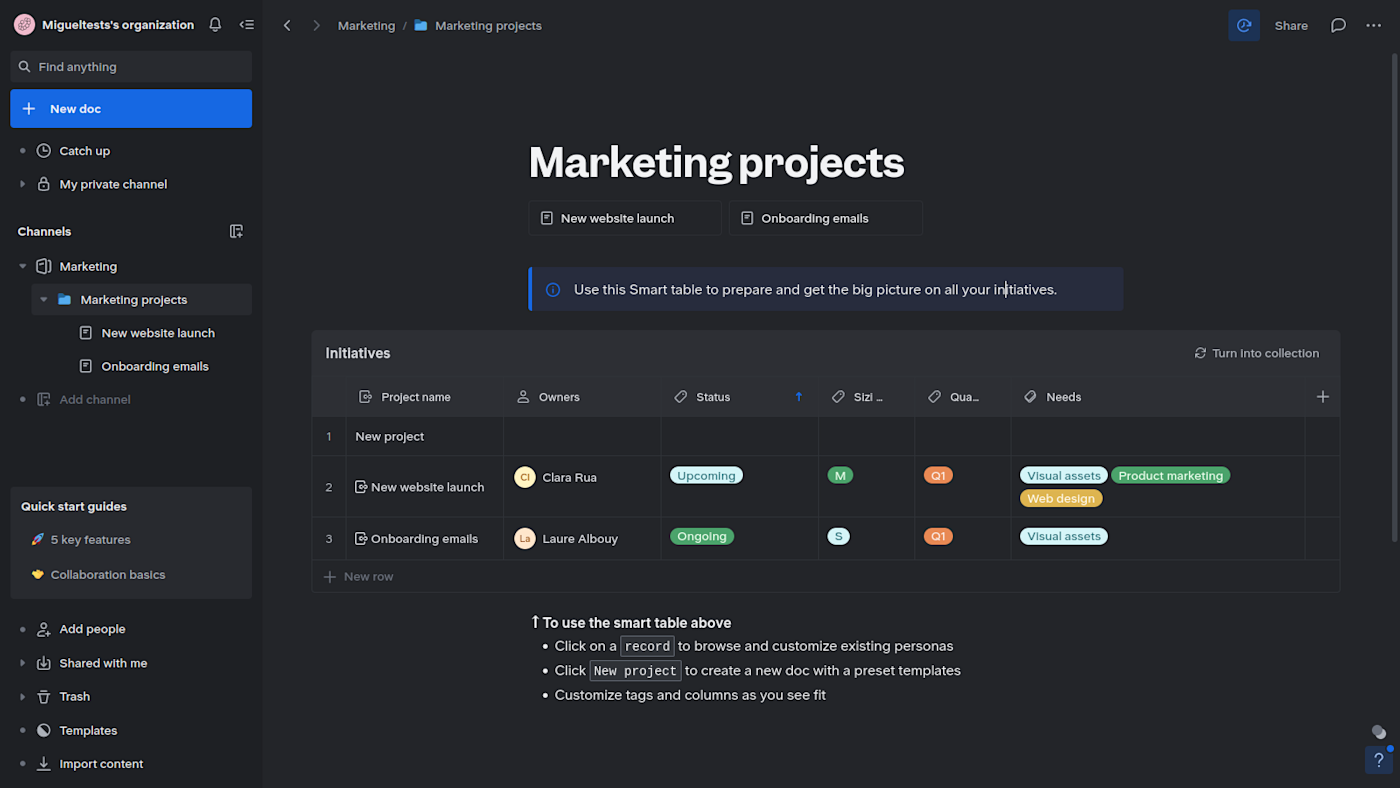
Slite‘s experience focuses on collaboration for a business setting, ready to plug and play into your daily company routines.
When you open the app, the first thing you see is the catch-up section of the workspace. Slite’s philosophy divides your work into two major areas: (1) your private channel, a space where you can store your own documents and databases and (2) channels, which act as folders for different departments or topics within your company.
This user experience is more structured, more on-rails. The left-hand menu feels a bit cluttered, but it captures well all the regular actions you’ll be taking in Slite. Navigating between documents is akin to the traditional file and folder experience. The standard mentions and comments features are there, easier to keep track of due to the catch-up section and the notification list. The open sky feeling isn’t really there until you open a document, start organizing your information, and create your own navigation.
There are some new content blocks in Slite that I hadn’t seen on other platforms. One is the directory, where you create a place to hold similar documents, such as meeting notes. This directory allows you to set templates and even create recurring documents. Have a meeting at 11 a.m. every Monday? Slite will get the document ready for you and automatically share it with everyone who’ll be there. I also really liked the sketching block, which was surprisingly easy to use, with all the aesthetic elements resembling handwriting, even if you’re drawing a perfect ellipse on the canvas. The sketch embeds perfectly within the document, a welcome addition to boost visual thinking.
With these strong document and collaboration features, you’d expect a mind-blowing database experience. Slite is strong but doesn’t impress, giving you the power to create simple databases (called collections), with a limited number of data types (no formulas or relational database features, but has links to other docs) and the ability to apply filters you can save and set as default. It covers the basics and gives that organizational edge to keep the document experience in top shape.
In the end, Slite is a good candidate to host all your business knowledge and processes, except for two key things: Kanban boards are nowhere to be found, and the database features are light. Slite compensates by delivering a strong document and team collaboration experience, though, so consider what you need for your particular use case and see if the app can match it.
-
Slite difficulty: Beginner.
-
Slite pricing: Free plan for up to 50 documents. Paid plans start at $6.67/user/month (billed annually).
Best Notion alternative for privacy, security, and data relationships
Anytype (Web, iOS, Android)
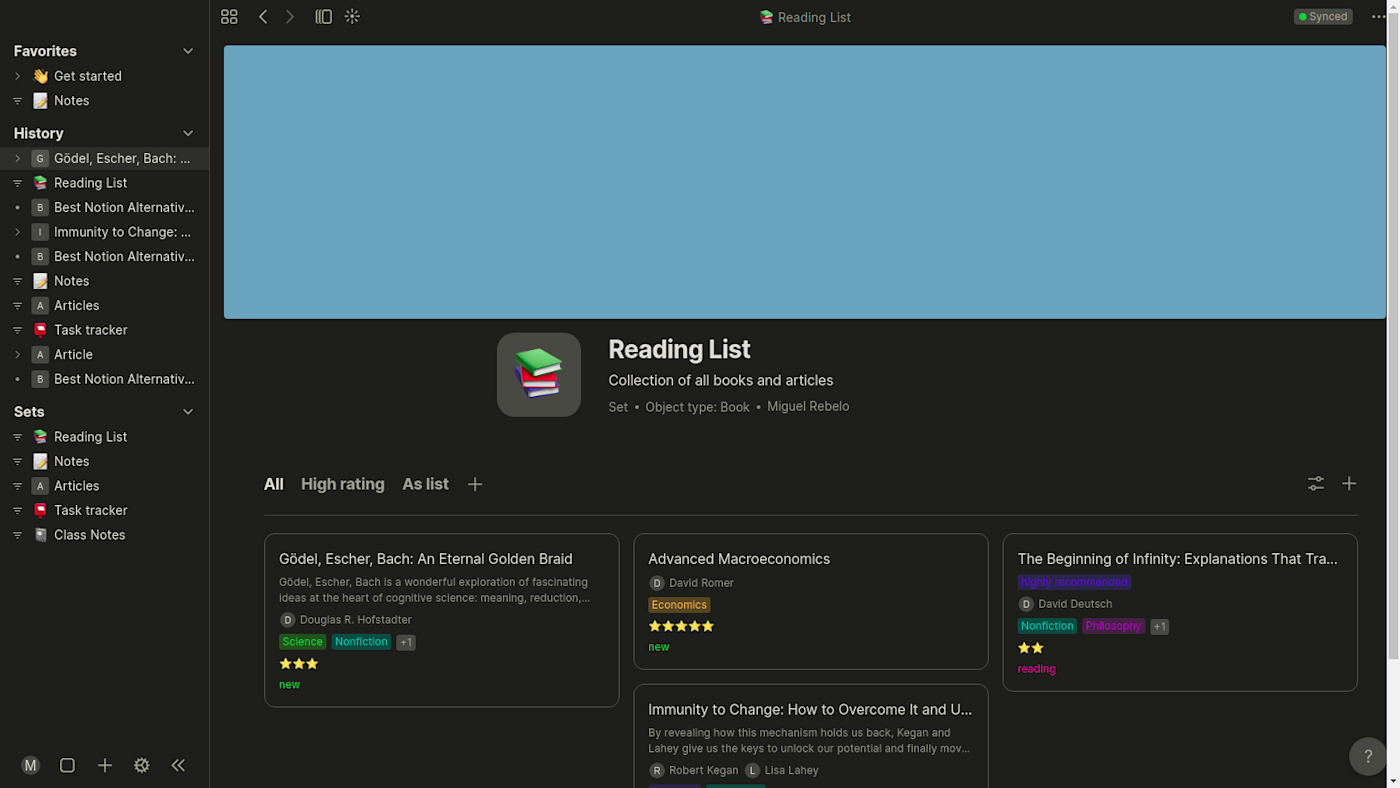
A note before we begin: Anytype is in alpha stage. All the features for individual users are well implemented, and the team is planning to move on to what they call “multiplayer Anytype” (enabling collaboration features) sometime in 2022.
I confess to being hyped about Anytype—I signed up for the alpha with excitement. The ambition in the website is palpable: the ultimate objective is to create an entire ecosystem that’ll even support apps and P2P services. But since productivity doesn’t run on hopes and dreams, I cleared my head and started testing.
The dashboard shows the pages you’ve set as favorites, your sets (databases), as well as recently opened pages, shared files, and the bin. Once you click on one of the links shown there, you jump into the library, with the familiar interface of apps in this category.
The philosophy is different from Notion. Everything within Anytype is an object. I’m an object with the “human” property. I set relationships with the objects I create, be it documents, notes, or invoices, to name a few. An author of a book I read is an object, the books they wrote (also objects) appear in relation to the author, and the notes I’ve made about each book (yup, objects) are related to each book in the same way.
This kind of linking through relationships doesn’t happen in just one way. Anytype has something called bidirectional linking: linking one object to another enables you to move from A to B, and also from B to A, a bit like backlinks with more features built upon it. This allows you to see information in a visual constellation chart (much like Nuclino) and as a sequence of relationships, where you can navigate upstream or downstream to see how information is connected.
The fact that everything is an object changes the experience in another way: to create a database, you first need to create the object type that’s going in it. I wanted to create a place to keep all my articles together. I pasted text and images on new objects in Anytype, but when I tried to create a database, it didn’t work. I needed to convert the objects I’d just created into an Article object, with its own set of properties and templates, and then put it inside the database. Sadly, there aren’t a lot of views available yet—only list, grid, and board (not Kanban)—but filters are already working well.
As for the offline mode, all data lives inside your device, encrypted by a unique passphrase assigned to you when you log in for the first time. Lost the passphrase? Goodbye, data. No one, not even the Anytype team, can recover data without the passphrase. Once you get it, keep it safe in a password manager.
Syncing across devices can be done via a cloud server that the Anytype team set up for alpha users. You can turn off the Wi-Fi at any time and still be able to work. Syncing with other devices requires you to update your cloud backup, install Anytype on your secondary device, and wait until it downloads everything. This cloud feature will be paid in the future, being the monetization strategy for the app going forward, both for personal and business users. But if you want to self-host Anytype and run your own server or storage service, you can do it after it’s released out of beta.
Can Anytype work as an all-in-one at the moment? The final verdict is mixed. If you don’t need collaboration features, it definitely can. The document features and the way databases work have a lot of depth, and the app is fast and stable. Is being in development stage a problem? If you need a proven, stable tool, it’s a problem; if you want to hop on the forums, engage with other users and the dev team, and suggest your own feature wishlist as you follow the growth, then you’ll be delighted by the experience.
Anytype made it to the roundup for being surprisingly solid for an alpha-stage app, for introducing welcome twists to the category, and for all the potential it holds. If you’d like to hop in, the estimated waiting time is two months—but I got access in three days without doing anything else.
Best Notion alternative for fearless tinkerers
Obsidian (Mac, Windows, Linux, iOS, Android)
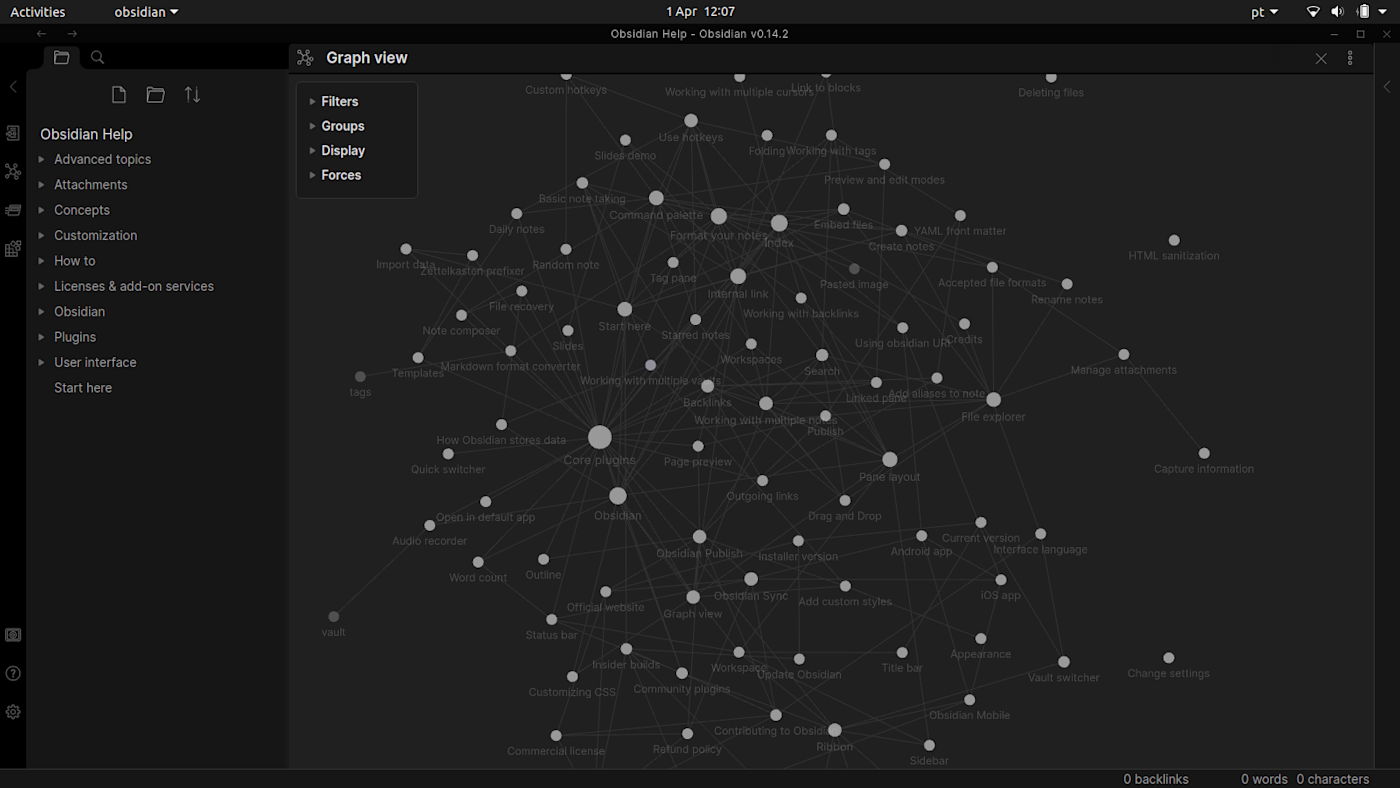
There’s a special kind of person looking to move away from Notion. They fell in love with it, know the entire documentation section by heart, probably even made some money selling Notion templates. They maxed out the platform’s features, and their occupation is now finding ways to hack the limitations to squeeze out an extra ounce of freedom and productivity.
If this is you: first, respect. Getting to the bottom of Notion is not for everyone. Second, you’ve outgrown Notion, and you need a new playground to create more ambitious solutions. You don’t have to become a developer, build an MVP, raise funding, and build a competing app to do so.
Obsidian brings a unique open-endedness, inviting you to customize it with dozens of plugins. Many Obsidian users also abide by Zettelkasten, a knowledge management system to become a better (human) processor of information. You build it, and it builds you. While the latter is interesting, we’ll focus on the app itself for now.
At heart, Obsidian is a note-taking tool with a graph view, allowing you to see your ideas in a constellation. Most of the advanced features and plugins are turned off by default, but going to the settings menu will give you a long list of plugins to play around with. And while you can do a lot already with these first-party plugins (such as enabling a slash command menu), the community plugins allow you to add extra functionality to the app itself.
I’m using it to flesh out a personal writing project right now, and it feels light and agile. There’s a menu you can bring up with control + P, where you can type to change settings and add new elements quickly. Embedding media is counterintuitive, but getting the hang of it only takes a couple minutes and a Google search.
The most exciting part of this app is that you can transform it to suit your needs. Depending on your technical knowledge (or fearlessness), you can set up Kanban boards, calendars, and to-do lists; configure a spaced repetition system; and even add sketches to your notes. This isn’t even the full list, so there’s a lot more to discover.
All your documents live inside a “vault.” Since everything is stored locally—on a folder on your computer as Markdown files—your data is always yours. If you want to sync your data to the cloud, you can upload this folder to your file storage app of choice.
Collaborating with others requires some acrobatics, at least while the Obsidian team builds those features into the app. The easiest way is to create a vault, upload it to Google Drive, and share it with your team. Other methods include (brace yourself) setting up a free-tier server on a cloud hosting provider and connecting a live editing plugin.
Adding a database experience also requires tinkering, but some advanced users have successfully created their own database views inside Obsidian, even replicating (and surpassing) Notion’s database experience.
Is there all-in-one potential in Obsidian? Absolutely. Will it require you to learn as you go and invest a lot of time and patience? Yes, it will. And the end result might be a tool perfectly tuned to the way you gather, think about, and communicate information. High investment, high reward.
-
Obsidian difficulty: Starts at intermediate.
-
Obsidian pricing: Free for personal use. Paid add-ons for cloud storage and online publishing, as well as enterprise licenses available. Paid plans start at $25 for things like early access and support development.
Can Notion be beaten?
This category of Notion alternatives includes all sorts of approaches and features—some solutions start with entirely different mindsets. All the platforms on this list are either free or have a free plan to help you evaluate the features on offer, so take your time to experiment and see which one matches best with what you need. And hey, maybe Notion is the app for you after all.
[adsanity_group align=’alignnone’ num_ads=1 num_columns=1 group_ids=’15192′]
Need Any Technology Assistance? Call Pursho @ 0731-6725516

